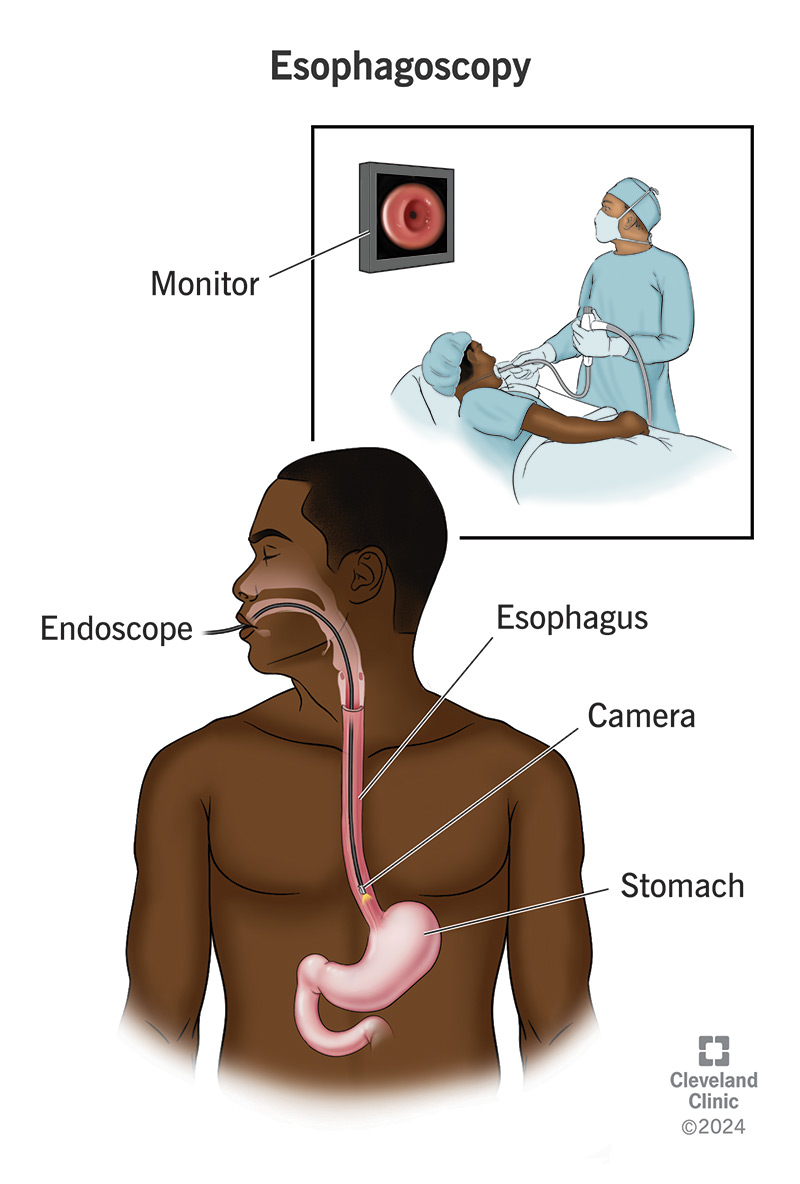Esophagoscopy is a medical procedure healthcare providers do to examine the inside of your esophagus. It involves passing a thin tube with lights and a video camera into your esophagus. Providers may do the test to diagnose conditions like Barrett’s esophagus or esophageal cancer, or to remove foreign objects from your esophagus.
Advertisement
Cleveland Clinic is a non-profit academic medical center. Advertising on our site helps support our mission. We do not endorse non-Cleveland Clinic products or services. Policy

An esophagoscopy (ee-SAH-fuh-GOS-koh-pee) is a procedure that healthcare providers use to check the inside of your esophagus — the tube that carries food and liquid from your throat to your stomach. Your provider may do an esophagoscopy to look for signs of disease or to take tissue samples.
Advertisement
Cleveland Clinic is a non-profit academic medical center. Advertising on our site helps support our mission. We do not endorse non-Cleveland Clinic products or services. Policy
The procedure is a type of endoscopy. Healthcare providers use an endoscope to examine structures inside your body. An endoscope is a long, flexible tube with a camera and a light on the end. A provider inserts an esophagoscope into your mouth or nose. They move the scope down your throat to your esophagus.
You may feel anxious about a tube going down your throat or nose. That’s completely normal. But the test is one way to find out what’s going on in the tube you rely on to keep food and liquid moving. And that’s the first step toward feeling better.
Your healthcare provider may do this test if you have symptoms like:
You may need an esophagoscopy if there’s food caught in your esophagus, or you swallow something by accident.
Healthcare providers also do this procedure to diagnose esophageal disorders, including:
Advertisement
The tests work the same way. Lighted video cameras in the esophagoscopes send images to a computer screen. Esophagoscopes may be flexible tubes that bend. They could be narrow, metal tubes that don’t bend (rigid esophagoscopy).
Some esophagoscopies involve anesthesia so you don’t feel pain during the procedure. Your healthcare provider will explain what you need to do to get ready. In general, however, you should:
Your anesthesiologist gives you medication to put you to sleep or sedation to help you relax. Your healthcare provider will:
That depends on the type of test you have. A transnasal esophagoscopy may take 15 minutes to complete. A transoral esophagoscopy may take up to 60 minutes. Your healthcare provider will explain what you can expect.
No, they aren’t painful. You may feel uncomfortable as your provider inserts the esophagoscope but the procedure isn’t painful.
Esophagoscopies are outpatient procedures (you can go home the same day). But you’ll need to stay at your provider’s office or at the hospital until you recover from anesthesia. For example, it may take an hour for the medication that numbed your throat or nose to wear off.
Benefits include:
Esophagoscopies are safe procedures with very few complications. When there are complications, they may include:
Healthcare providers do esophagoscopies for different reasons. For example:
Advertisement
Your healthcare provider may share your test results right away. If your provider takes tissue samples, it may be a few days to a week before they receive the results. If that’s the case, your provider will tell you when they expect to get results.
Contact your provider if you develop the following symptoms:
Both procedures are types of endoscopies. Healthcare providers do a bronchoscopy to diagnose problems with your trachea (windpipe) or lungs.
A healthcare provider may do an esophagoscopy if you have symptoms like a burning feeling in your chest. Esophagoscopies aren’t painful, but they can be uncomfortable. If you’re feeling anxious about the test, don’t hesitate to tell your provider. They’ll be happy to explain what you should expect and how they’ll support you during and after your test.
Advertisement
Breathing issues can affect your life in many ways. Cleveland Clinic’s respiratory therapy program treats your symptoms so you can feel better day to day.

Last reviewed on 12/03/2024.
Learn more about the Health Library and our editorial process.